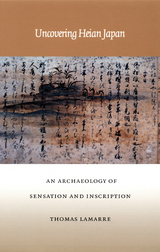2 books about 794-1185

Real and Imagined
The Peak of Gold in Heian Japan
Heather Blair
Harvard University Press
During the Heian period (794–1185), the sacred mountain Kinpusen, literally the “Peak of Gold,” came to cultural prominence as a pilgrimage destination for the most powerful men in Japan—the Fujiwara regents and the retired emperors. Real and Imagined depicts their one-hundred-kilometer trek from the capital to the rocky summit as well as the imaginative landscape they navigated. Kinpusen was believed to be a realm of immortals, the domain of an unconventional bodhisattva, and the home of an indigenous pantheon of kami. These nominally private journeys to Kinpusen had political implications for both the pilgrims and the mountain. While members of the aristocracy and royalty used pilgrimage to legitimate themselves and compete with one another, their patronage fed rivalry among religious institutions. Thus, after flourishing under the Fujiwara regents, Kinpusen’s cult and community were rent by violent altercations with the great Nara temple Kōfukuji. The resulting institutional reconfigurations laid the groundwork for Shugendō, a new movement focused on religious mountain practice that emerged around 1300. Using archival sources, archaeological materials, noblemen’s journals, sutras, official histories, and vernacular narratives, this original study sheds new light on Kinpusen, positioning it within the broader religious and political history of the Heian period.
[more]

Uncovering Heian Japan
An Archaeology of Sensation and Inscription
Thomas LaMarre
Duke University Press, 2000
The poetry of the Heian court of Japan has typically been linked with the emergence of a distinct Japanese language and culture. This concept of a linguistically homogeneous and ethnically pure “Japaneseness” has been integral to the construction of a modern Japanese nation, especially during periods of western colonial expansion and cultural encroachment. But Thomas LaMarre argues in Uncovering Heian Japan that this need for a cultural unity—a singular Japanese identity—has resulted in an overemphasis of a relatively minor aspect of Heian poetry, obscuring not only its other significant elements but also the porousness of Heian society and the politics of poetic expression.
Combining a pathbreaking visual analysis of the calligraphy with which this poetry was transcribed, a more traditional textual analysis, and a review of the politics of the period, LaMarre presents a dramatically new view of Heian poetry and culture. He challenges the assumption of a cohesive “national imagination,” seeing instead an early Japan that is ethnically diverse, territorially porous, and indifferent to linguistic boundaries. Working through the problems posed by institutionalized notions of nationalism, nativism, and modernism, LaMarre rethinks the theories of scholars such as Suzuki Hideo, Yoshimoto Takaaki, and Komatsu Shigemi, in conjunction with theorists such as Derrida, Karatani, Foucault, and Deleuze. Contesting the notion that speech is central to the formation of community, Uncovering Heian Japan focuses instead on the potential centrality of the more figural operations of poetic practice.
Specialists in Japanese history and culture as well as scholars working in other areas of cultural criticism will find that this book enriches their understanding of an early Japan that has exerted so much influence on later concepts of what it means to be Japanese.
Combining a pathbreaking visual analysis of the calligraphy with which this poetry was transcribed, a more traditional textual analysis, and a review of the politics of the period, LaMarre presents a dramatically new view of Heian poetry and culture. He challenges the assumption of a cohesive “national imagination,” seeing instead an early Japan that is ethnically diverse, territorially porous, and indifferent to linguistic boundaries. Working through the problems posed by institutionalized notions of nationalism, nativism, and modernism, LaMarre rethinks the theories of scholars such as Suzuki Hideo, Yoshimoto Takaaki, and Komatsu Shigemi, in conjunction with theorists such as Derrida, Karatani, Foucault, and Deleuze. Contesting the notion that speech is central to the formation of community, Uncovering Heian Japan focuses instead on the potential centrality of the more figural operations of poetic practice.
Specialists in Japanese history and culture as well as scholars working in other areas of cultural criticism will find that this book enriches their understanding of an early Japan that has exerted so much influence on later concepts of what it means to be Japanese.
[more]
READERS
Browse our collection.
PUBLISHERS
See BiblioVault's publisher services.
STUDENT SERVICES
Files for college accessibility offices.
UChicago Accessibility Resources
home | accessibility | search | about | contact us
BiblioVault ® 2001 - 2024
The University of Chicago Press









